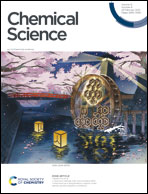Isomeric anthracene diimide polymers†
Abstract
N-type semiconducting polymers are attractive for organic electronics, but desirable electron-deficient units for synthesizing such polymers are still lacking. As a cousin of rylene diimides such as naphthalene diimide (NDI) and perylene diimide (PDI), anthracene diimide (ADI) is a promising candidate; its polymers, however, have not been achieved yet because of synthetic challenges for its polymerizable monomers. Herein, we present ingenious synthesis of two dibromide ADI monomers with dibromination at differently symmetrical positions of the ADI core, which are further employed to construct ADI polymers. More interestingly, the two obtained ADI polymers possess the same main-chain and alkyl-chain structures but different backbone conformations owing to varied linking positions between repeating units. This feature enables their different optoelectronic properties and film-state packing behavior. The ADI polymers offer first examples of conjugated polymer conformational isomers and are highly promising as a new class of n-type semiconductors for various organic electronics applications.

- This article is part of the themed collection: In celebration of Chinese New Year, 2022


 Please wait while we load your content...
Please wait while we load your content...